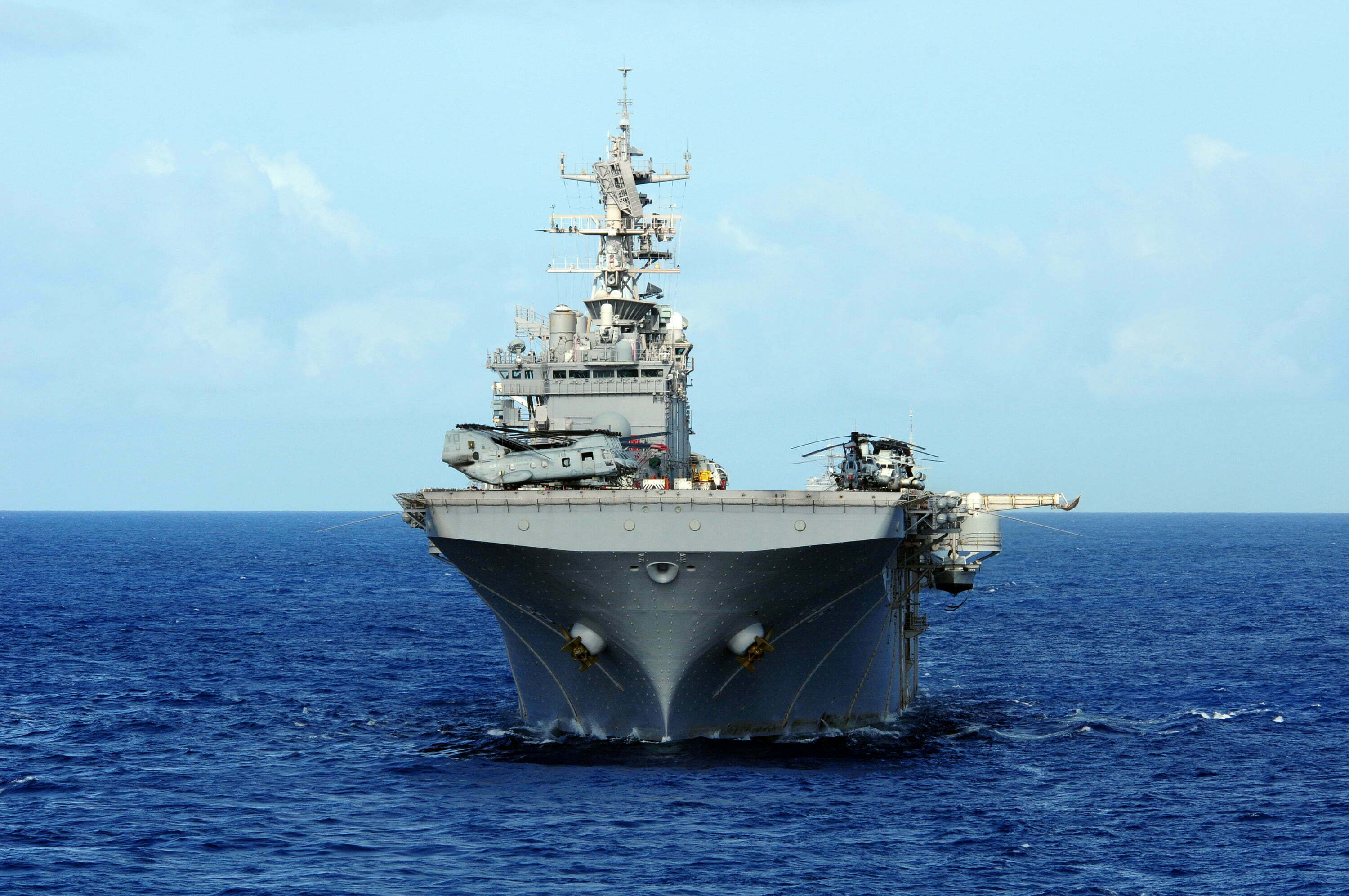2013-02-01 by Robbin Laird
At Second Line of Defense, we have conducted a number of interviews with Commander’s with special roles in the Pacific. In this article, we want to bring together some of those insights into a more comprehensive look at the challenges as seen by the Commander’s who are responsible for the execution of Pacific strategy.
The core interviews, which we are drawing from in this piece, are listed at the end of the piece.
A central perspective of all of the interviewees was simply the size of the Pacific AOR and the challenge of operating limited forces over such a large region.
Concern was evident throughout with the limitations on available resources to operate throughout the depth and scope of the Pacific.
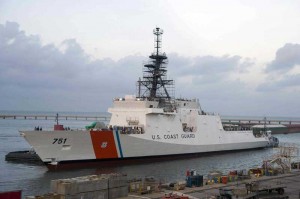
For the USCG, the absence of cutters and the concern over the future numbers of the National Security Cutter was matched by USMC concern about the numbers of amphibious ships.
In all of the discussions, the significant demand on current resources was highlighted.
For example, MARFORPAC conducted over 100 exercises and events, spread across 48 countries inside and outside the AOR.
Among these activities were the following:
- Response to disasters in the Philippines and Thailand,
- Conducted Non-Lethal Training that brought together diverse countries such as Vanuatu and Mongolia,
- Trained with the French in New Caledonia and in Hawaii, the Singaporeans and Indians in California as well as their countries,
- Worked on Disaster Relief planning in Kathmandu,
- Conducted ground-breaking experiments with TAK-E shipping and Marines in the Maldives
- Trained alongside Chileans in RimPac, and celebrated 70 years of bonds with the New Zealanders through visits to Wellington and Auckland.
MARFORPAC also deployed the first Marines to start a more permanent presence in Australia.
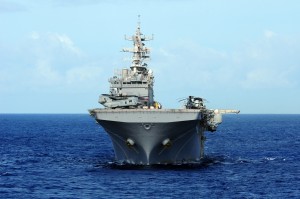
Through the training efforts the USMC established an operational presence across the entire region. Training kept deployed Marines as the ready force to respond when these crises occurred.
By training forward in the region, the USMC-USN teams was able to be responsive when a crises occurred, such as responding to flooding in Thailand and the Philippines with forces that were already there for exercises.
It was clear from the interviews as well how that demand made it difficult to move forward on a new strategy without investment in new platforms and systems.
Implicitly, if the US does not invest in moving forward with new platforms and systems, there is an inevitable shortfall in any US capability to play its role in the Pacific.
For General Hostage, there is no alternative but to build out air capability with F-35s. He clearly is concerned with numbers, and the need to build out a serious fleet of F-35s to provide for the kind of “combat cloud” crucial to cover an area as large and vast as the Pacific.
And the fleet implications are also about innovative new ways to work with allies.
The F-35s are central to the transition. We are operating in contested air space, and need to shape a distributed air operations capability.
The F-22s aggregated in appropriate numbers can do some amazing and essential tasks, and with a significant number of F-35s, we can reshape the operational space.
The ability of the planes to work with each other over a secure distributed battlespace is the essential foundation from which the air combat cloud can be built.
And the advantage of the F-35 is the nature of the global fleet.
Allied F-35s and American F-35s, whether USAF, USN, or USMC, can talk with one another and set up the distributed operational system. Such a development can allow for significant innovation in shaping the air combat cloud for distributed operations in support of the Joint Force Commander.
http://defense.aol.com/2013/01/10/why-the-air-force-needs-a-lot-of-f-35s-gen-hostage-on-the-com/
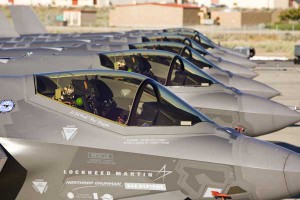
In addition to concern with diminishing platform numbers, concerns were expressed throughout about new challenges and threats to be dealt with.
For Dr. Lewis, the emergence of hypersonic missiles would be in the mix in the mid-term future and part of the answer to the tyranny of distance.
Modern warfare is about doing things quickly. It’s about achieving fast effects, getting results quickly. If you want to affect something quickly, I can think of basically three options.
The first option is that you have ubiquitous presence. That means you’ve got an asset anywhere you need it. That asset might be unmanned, and frankly, that’s a lot of what remotely piloted aircraft are enabling for us – having small assets available and re-locatable at a moment’s notice. Of course, ubiquitous presence is only good in a limited area; we obviously can’t have ubiquitous presence at every location around the globe, but that’s one part of the solution that is already changing warfare.
The second option for doing things quickly is to operate at the speed of light. For my aerodynamics friends, the speed of light is about a million times faster than the speed of sound. Operating at light speed means using directed energy systems and/or cyber systems, which are among the other things that Mr. Wynne championed when he was Secretary of the Air Force. And of course, there’s a lot of development underway right now in directed energy systems, and lots of corresponding questions about how we ultimately would deploy them, as well as how we would ultimately use cyber systems.
If you don’t have the first two available, or if they cannot deliver the desired result, a third option is that you get to where you want to go as fast as you possibly can. That’s the advantage of hypersonics. This could be to perform reconnaissance of some sort, do some sensing, or to deliver weapons on a target. In order to do that, we need to master the technology required to fly at hypersonic speeds.
Hypersonics would also give us a degree of invulnerability. We know that the application of stealth technologies has been a tremendous game-changer, but that stealth advantage won’t last forever. I would argue that the next step beyond stealth is speed.
For General Jacoby, the addition of the Arctic meant new challenges and new demands for resources.
As I look at the Arctic, I think of it in terms of where there is key terrain that we must be prepared to defend. Just like I look at where our key terrain is in the homeland – Washington, D.C., or the New York Stock Exchange, for example — I need to know where the key terrain is in the Arctic.
The Bering Strait, for instance, has the potential to become another Strait of Malacca. As the ice melts, it will take on significant and global economic importance. There are also locations where mining or energy extraction will take place.
Capability gaps create vulnerabilities.
I have direction in the Unified Command Plan to look carefully at what these might be, and advocate for ways to fill them. Of course, we will not do this alone. Our principal ally in the Arctic is Canada, and we have a shared stake with them in the peaceful development of the Arctic.
But it’s important to remember that the Bering Strait is not the Strait of Hormuz. This is an evolving issue, not a today issue.
We need to make advances over time that allow us to stay ahead of evolving problems, with a solid strategic direction defined and in place.
There is a school of thought that says we can have competitive commercial and economic interests in the Arctic, but not have any associated security challenges.
That’s simply not the way the world works.
Economic opportunities and challenges shape or imply security interests. We need to not only be prepared to take advantage of and exploit the economic opportunities in the Arctic, but also to be prepared to address security challenges.
http://defense.aol.com/2012/12/14/america-allies-and-the-arctic-northcom-commander-talks-polar-st/
For Lt. General Jouas, the evolving North Korean missile capabilities ramps up the challenges to providing for the kind of air superiority crucial to deterrence in the future.
Air power is an essential element in Korea. This is a “come as you are” fight over here. No one is going to let us reinforce for six months; when people take on the United States, they know they don’t want to give us the time to build up our forces.
Dr. Bracken provided the most explicit focus on the nuclear threat in the region. In his book and his discussion with us, he focused on the impact of both North Korean and Chinese nuclear capabilities.
Too often, analysts assume conventional forces are simply the coin of the realm in the Pacific. They are not.
As Bracken put it:
The kind of crisis in which learning might occur could revolve around something like the Pacific islands in dispute in the South China Sea.
If there’s a major Chinese move against one of these islands, the Japanese and US forces will be forced to respond.
But what if the Chinese start moving some nuclear weapons around.
What do we do then? …
A common emphasis throughout was the need for what Lt. General Robling called “persistent presence.” If you are not there, you are not a player.
The United States has been a significant presence in the region throughout the post-war period. And that presence has been significant glue in the region facilitating both security and economic growth. Our allies and partners certainly recognize this and are a looking at new ways to work with us to get that persistent presence.
A key driver of demand is from partner nations, as well as the more obvious allies. South Korea, Japan, Australia and Thailand are certainly core allies, but we have growing demand from and opportunities with Cambodia, Vietnam, India, Malaysia and Indonesia for expanded working relationships.Coupled with the “persistent presence” theme was a significant emphasis upon partnering and alliances and innovations in ways of working with other forces.
As Vice Admiral Manson Brown emphasized in his treatment of the presence theme:
And it’s presence, in a competitive sense, because if we are not there, someone else will be there, whether it’s the illegal fishers or whether it’s Chinese influence in the region. We need to be very concerned about the balance of power in the neighborhood.
If you take a look at some of the other players that are operating in the neighborhood there is clearly an active power game going on.
SLD: Basically, not being there is its own message, so to speak?
Admiral Manson Brown: That’s exactly right. When I was in Tonga, I observed large structures built by the Chinese government and am watching others nations expand their influence around the world.
But there is another important reason that we should be there. It’s another aspect of national security. If you take a look at the march of terrorism through places such as Indonesia, it’s not too difficult to craft an instability scenario where it could leap to Oceania, allowing our enemy to potentially get closer to reach out and touch us.I remind people that even though American Samoa is a U.S. territory, once you get to American Samoa, you’re in America. It’s not too difficult to reach out and touch us from there.
A key theme for the Commanders was shaping an effective logistic and sustainment approach to supporting a widely deployed fleet of aircraft and ships.
The interview with the head of the Military Sealift Command provided an important “reality” check to the challenge of supporting deployed assets over a wide swath of ocean.
The interview with Admiral Buzby highlighted many of the innovations which the MSC is implemented, but the challenge of supporting an afloat force.
The discussion we had with him about the Littoral Combat Ship was a good reminder of the growing demand set on an MSC which was not growing in numbers of support ships.
SLD: Speaking of the LCS, and the question of the demand side posed by deployed LCS’s, how will they impact on your workload? It probably depends on how the LCS is deployed, because if it is dispersed that would be challenging for the MSC fleet.
Admiral Buzby: It’s going to make us very busy. We’re busy now; it’s going to make us even busier. And those particular ships have one refueling station, and they have no connected replenishment, so the only way they can get their supplies at sea is via vertical replenishment on the flight deck.
Several of the Commanders focused on innovations that they were making to try to cope with the gap between demand and supply for security and defense forces.
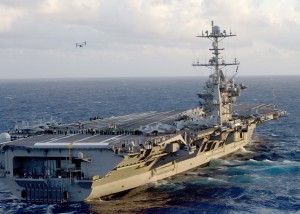
For example, Major General Owens discussed how the Osprey was being leveraged to allow the USMC to be able to operate over a wider area and on a wider variety of platforms and locations to shape presence capabilities.
When I was a young lieutenant and captain, I think we had somewhere in the neighborhood of 65 amphibious war ships in the Navy inventory. Right now, we have 28 and they’re spread about as thin as they possibly can be. We’re running through their lifecycle faster than anticipated, and yet they’re never enough.
Going back to the whole challenge in this AOR is getting to where you need to be with some capability. Being able to stretch the legs of the aircraft and operate from austere sites is critical.
A good case in point is that we just brought a couple of KC130s back from disaster relief in the Philippines, a typhoon rolled through Mindanao and Palawan a few weeks ago. And we deployed a couple of KC130s to haul relief supplies from Luzon to Mindanao.
The KC-130J was the aircraft of choice because there was a useable airfield at the southern end, at the affected end. But had there not been an airfield, which is often the case after tsunamis and typhoons, we could have done the same thing with the Osprey; flown it to Clark Field, operated out of Luzon — loading supplies in Luzon and dropping them to a point landing site in Mindanao supported by KC130s in the air, providing aerial refueling.
And it’s a capability we’ve never had before, and I expect that within the next couple of years, we’ll have an opportunity to demonstrate that the Osprey may be the only aircraft that can get in to an affected area at the distance that we’ll be required to support from.
Whether it be from an intermediate staging base, like Clark or flying directly from MCAS Futenma here in Okinawa.
For Vice Admiral Manson Brown, the new National Security cutters were crucial to meeting the security challenges of the Pacific.
With the vast distances, which we refer to as the tyranny of distance out here, if you don’t have enduring presence, which cutters bring, then you’re not going to get to where you may be needed in an emergency in time, particularly in a place like the Bering Sea.
An especially important modernization effort revolves around C2 and IW systems to be developed, deployed and integrated in US and allied forces in the Pacific. And there are clear flash points or decision points, which can be leveraged to highlight modernization opportunities.
Such is the case with the coming transition in the command structures in South Korea.
The OPCON transition plan envisions South Korea as taking the lead in defense against North Korea as well as in other operational plan requirements. The ROK Joint Chiefs of Staff (JCS) will lead warfighting while the U.S. Korea Command (KORCOM) will become a supporting command, and the cur- rent U.S.-ROK Combined Forces Command (CFC) will disappear.)
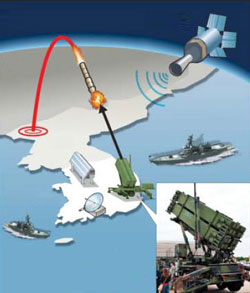
As Lt. General (Retired) Wood put it:
SLD: What is the biggest challenge moving forward to make this work?
Wood: The first thing you need to accomplish is further modernization of Command and Control. It will be crucial that everything digital…all data links are fully operational and interoperable…and they must be linked up in order to establish a robust command and control capability. This networking must be exercised routinely in the same way any campaign plan would fully exercise and challenge command and control.
Such modernization will require significant investment in new equipment and also at the lower levels of echelon at the squadron, infantry battalion and even lower, at the company and platoon level. This is an imperative to ensure positive command and control across the entire battle space.
It’s also critical that when procuring this new equipment, the South Koreans ensure that it’s compatible with U.S. equipment in order to ensure a 360-degree, 3 dimensional view of the battle space and seamless coordination of all operations against a disruptive enemy within the area of responsibility.
Another key theme discussed was the need to shift to a more distributed force capability approach.
This was discussed differently with the different Commanders, although the USMC has the clearest statement and approach shaped around the evolution to distributed operations.
Lt. Gen. (Retired) Charles R. Heflebower had an interesting take on the need for such a shift with regard to South Korean defense.
It is a joint fight and there is a need for joint forces able to support a credible U.S. engagement capability. But in my view there is a difference between South and North Korea. The North views US air and maritime power as the key to getting their attention; the South Koreans see the ground forces as a reassurance of the willingness of the U.S. to spill blood in their defense.
The joint air and maritime forces are a key element in terms of interdiction and bottling up North Korea and dealing with their very substantial Special Forces, USAF, USMC and USN air are key.
The ability to surge in force is crucial. When I was there, I calculated that if we could remain viable through the first 20 days of combat, forces could be surged to the area and turn the tide.
In this sense, Alaska is a crucial asset to any American Pacific strategy.
People don’t realize how strategic Alaska is until you really look at a map and recognize its central role in terms of getting forces into the region. I liked having both forces in Japan/Alaska because we could get them there fairly quickly and affect any battle calculations by the North.
In general, to have an effective Pacific strategy we have to have distributed forces in the region.
There are a lot of little lily pads we ought to be developing.
A final theme which was discussed but not highlighted in the interviews was the anti-access, anti-denial challenge posed by the Chinese among others.
Because these were commanders, they were not treating the problem as fixed in concrete, but very much in terms of dealing with the reactive enemy. It is a problem not a final statement of inability to deal with a problem.
Many of the new technologies were seen as part of the solution set for anti-access and anti-denial, and probably the F-35 often seen as a key element in shaping a solution set.
Indeed, for many of these commanders the F-35 was not looked at as a classic tactical aircraft measured by range, but a node in a network where the question was reach. And the ability to deploy forward sensors was seen as a key element of an evolving approach.
As Lt. General Jouas put it:
SLD: Lt General Deptula often makes the point that the F-22 and the F-35 is not really an F but is an ISR platform in a new way. How do you look at these developments?
LT. GENERAL JOUAS: I’ll just say it has an inherent ISR capability that we can exploit. And as our sensors join together to form a common picture, hopefully that would integrate with the ground and naval components’ capabilities, so that we can rapidly target the developing threats before they are in position to employ.
And that’s just one example. When the F-22 and F-35 will be over flying any terrain, and relay what it sees and what it senses, and have that distributed to other weapon systems, we will have a significant growth in capability.
Another Commander framed the challenge a bit differently.
He argued that the current thinking about anti-access, anti-denial is too narrowly focused.
The Chinese have an advantage if they can use their resources on the mainland to support operations fairly close to their territory.
But that is not the strategic direction in which they are headed.
They are coming out into the Pacific. And if we build the appropriate distributed force able to work closely with allies, then they have a different kind of anti-access, anti-denial problem of their own.
Interviews from which article was generated are as follows:
Lt. General Terry Robling, MARFORPAC Commander
Lt. General Jan-Marc Jouas, 7th USAF Commander
https://sldinfo.com/meeting-the-korean-defense-challenge-the-view-from-7th-air-force/
General Jacoby, NORTHCOM/NORAD Commander
https://sldinfo.com/preparing-for-an-arctic-future-general-jacoby-looks-at-the-challenges/
General Hostage, ACC Commander
https://sldinfo.com/shaping-the-way-ahead-for-airpower-general-hostage-focuses-on-the-future/
Major General Christopher Owens, Commanding General, 1st MAW
https://sldinfo.com/shaping-operational-flexibility-an-interview-with-major-general-owens/
Vice Admiral Manson Brown, then Commander of the USCG in the Pacific
https://sldinfo.com/the-uscg-in-the-pacific/
Admiral Buzby, Military Sealift Command
And given the special role, which new technologies might play in reshaping the theater, the discussion with former Chief Scientist of the USAF, Dr. Mark Lewis provides important insights as well.
https://sldinfo.com/hypersonics-special-report/
And we can add to the mix, the crucial insights provided by Dr. Paul Bracken with regard to the evolving challenges of deterrence in a nuclear proliferation age.
We supplemented the Jouas interview with two interviews of former 7th USAF Commanders as well:
Lt. General (Retired) Stephen Wood
https://sldinfo.com/south-korean-defense-re-considered-preparing-for-2015/
Lt. Gen. Charles R. Heflebower
https://sldinfo.com/understanding-the-challenge-of-deterring-north-korea/


